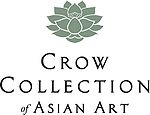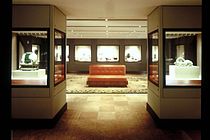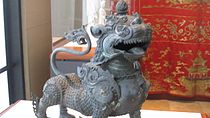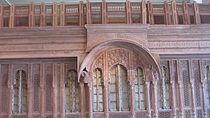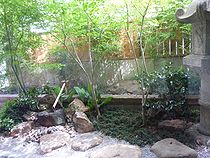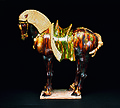- Trammell & Margaret Crow Collection of Asian Art
-
 Mr. and Mrs. Trammell Crow.
Mr. and Mrs. Trammell Crow.
The Trammell & Margaret Crow Collection of Asian Art, located downtown Dallas, Texas (USA), is a member of the Dallas arts district and offers free daily admission. The museum is a gift to the people and visitors of Dallas from Mr. and Mrs. Crow. It opened officially without charge to the public on December 5, 1998.
The Crow Collection is a permanent set of galleries dedicated to the arts and cultures of China, Japan, India and Southeast Asia. The museum offers a serene setting for quiet reflection and learning. The museum is located at the bottom of Trammell Crow’s own namesake tower, the Trammell Crow Center.
The Crow’s youngest son, Trammell S. Crow, is the president of the museum. Clarence Shangraw, a curator emeritus of the Asian Art Museum of San Francisco, was the consultant who selected the initial items for display.[1] Currently, Amy Lewis Hofland is Director and Dr. Caron Smith is Curator.[2]
The Crow Collection is on the social networks Twitter and Facebook.
 The Seated Daoist Deity welcomes visitors at the Crow Collection.
The Seated Daoist Deity welcomes visitors at the Crow Collection.
Contents
History
Trammell and Margaret Crow bought their first piece of Asian art in the mid-1960s, and from that initial purchase has evolved a distinguished collection featuring pieces from China, Japan, India and Southeastern Asia, spanning 3500 B.C. to the early 20th century. The Trammell and Margaret Crow Collection of Asian Art opened to the general public as a permanent museum in December 1998, at 2010 Flora in the Arts District of downtown Dallas.
The Crows have traveled extensively throughout the world, but Asia is a favorite destination. "Our first visit to China came in 1976 right before Chairman Mao Tse-tung died," Mrs. Crow said. "Very few foreigners were allowed inside China at that time, but we received permission because of Dallas Market Center’s involvement with the Canton Trade Fair."
Tight restrictions on exports from China prevented the Crows from making many direct buys of art during their 14 subsequent visits to the country. The majority of their collection has been obtained from individual purchases through private dealers and auction houses, as well as through the acquisition of major collections, such as the highly respected Morrie A. Moss collection. In total, the Crow family has amassed more than 4,000 pieces of Asian art, among which the 569 best were selected, after extensive analysis, by a noted curator for inclusion in The Crow Collection.
"Trammell has always loved Chinese art; it fascinates him, especially jade," Mrs. Crow said. "And I’ve always appreciated English décor, which has been influenced by the Chinese for centuries. So it was very easy for us to develop this partnership, this love for Asian art."
Pieces from Japan, India and other Southeast Asian counties were added as the Crows traveled to those countries as well. Their children's interest in Asian art also grew, particularly in their son, Trammell S. Crow, who now serves as president of the Crow Family Foundation and oversees the development of The Crow Collection. His interest was spurred while studying Chinese religion and history at Yale University. He has since traveled extensively throughout Asia and has acquired numerous works of art from his travels.
Mrs. Crow said the art, which ranges from Chinese jades and Buddhist sculpture to Japanese crystal spheres and screen paintings, has been displayed extensively in lobbies, reception and office areas at the Trammell Crow Center, other office buildings, marts, hotels, and in the homes of the Crows and their children. A baradari, a gazebo used in gardens of Indian palaces and residences for relaxation and meditation, spent years on the lakeshore at the Crow family farm in East Texas before its selection for the collection. "Because the art was scattered between commercial buildings and our families' homes, we had little notion of what kind of a collection we had until pieces were gathered for the exhaustive selection process," Mrs. Crow said.
The idea for the museum came about when Mr. and Mrs. Crow, married for 56 years, decided they would like to keep the collection intact as a legacy for their six children, 13 grandchildren and the general public. At that point, the interior of the Pavilion at the Trammell Crow Center was redesigned and renovated to meet the special needs of a gallery displaying centuries-old art year-round.[3]
Permanent collection
The Crow Collection has three galleries. The Gallery I is located on the first floor and is where Japanese art is shown, except when travelling exhibitions are on display. The Lotus Shop and garden flank Gallery I. The second floor is home to Gallery II and along with the mezzanine, is where Chinese artifacts are displayed. The Jade collection, one of the finest in the US and a pillar of the Crow Collection, is located here. Most of the items are from the 18th century, when the traditional Chinese jade industry (before the arrival of the industrial age) reached its zenith. There are many snuff bottles on display as well. The sky bridge connects Gallery II and Gallery III and is one of the most popular places in the museum. A glass structure held up by steel beams, the sky bridge looks at the Nasher Sculpture Center and the Trammell Crow Center and overlooks The Seated Daoist Deity fountain. Gallery III is dominated by the Mugal wall, which is hung from the ceiling due to its extreme weight, and two Indian gazebos. Gallery III is the primary site for Indian and Southeast Asia works of art.[4]
-
Tang Dynasty Horse, China, 8th century[4]
-
China, Qing dynasty, Kangxi period, 1672 Ink and pigment on silk[4]
-
China, Qing dynasty, 18th century Glass[4]
-
West India, Rajasthan, Mughal period, 18th century Sandstone [4]
-
Cambodia, pre-Angkor period, 7th century Sandstone[4]
-
Japan, Edo period, Kano-school style, 1850 Pair of six-fold screens; ink, pigment, silver and gold leaf on paper; wood, silk, and lacquer[4]
-
China, Qing dynasty, Qianlong period, 1762 Nephrite and gilding [4]
Past exhibitions
- Touching the Mekong: A Southeast Asian Sojourn (2006): Contemporary black-and-white photography depicts life in Southeast Asia. Imagine contemporary life in mainland Southeast Asia…Vietnam, Myanmar (Burma), Cambodia and Laos. Through more than 50 black-and-white images taken from 2001–2002, photographer Andrea Baldeck visually guides visitors through the cultures and into the lives of people living in Southeast Asia.[5]
- The Spinnaker Collection of Chinese Snuff Bottles (2007): The Spinnaker Collection of Chinese Snuff Bottles provides intriguing insight into the extraordinary lengths to which the Imperial workshops of Qing Dynasty China (1644–1912) sought to impress the Emperors, aristocrats and literati.[5]
- Changing Identity: Recent Works by Women Artists from Vietnam (2007): The show introduced the work of ten contemporary Vietnamese women artists who challenge the stereotypes and traditional roles of women in Vietnamese society. This exhibition was the first survey of women artists from Vietnam to tour the United States. Through the use of various media, subject matters, and aesthetic sensibilities, two generations of artists share views of their country and the changing status of women. Together their work provides a diverse view of Vietnam itself, reflecting a range of opinions and experiences.[5]
- Texas Collects Asia (2008): A series of five exhibitions that celebrate our ten-year anniversary. The Crow Collection of Asian Art presents a selection of impressive works that cover the below five topics:
- Japan
- India and Southeast Asia
- China
- Japanese Folk Art
- Contemporary Art[5]
- Untamed Beauty: Tigers in Japanese Art (2009): Untamed Beauty is an exhibition of tiger paintings, the products of the fertile imaginations of twenty-one Japanese artists. Many of Japan's most famous painters of the last three hundred years are represented in this remarkable exhibition. Tigers are not indigenous to Japan but their absence spurred fanciful ideas about their nature and physical form.[5]
- Yeohlee: Design For Now (2009): This was the first major exhibition in Dallas about the work of Yeohlee and feature selected fashion designs and concepts from Yeohlee’s 2004–2009 collections. The focus was on the evolution of her approach to design, which closely parallels architectural concerns but is ultimately attentive to the body. The exhibition explores four primary themes: Urban Nomad, Made in New York, Fluid Geometry, and Zero Waste.[5]
- Modern Twist: Bamboo Works from the Clark Center and the Art of Motoko Maio (2010): The Crow Collection explores the intersection of tradition, innovation, and design by pairing the traditional arts of basket making and screen making- the first a selection of works form the Clark Center in Hanford, California, and the second the exquisite work of artist Motoko Maio.[5]
- New Vision: Ballpoint Drawings by Il Lee (2010): Il Lee is a New York artist who for over 30 years has been exploring contemporary possibilities in drawing and painting in his chosen medium of ball point pen. In exploring the language of modernism Lee has moved through minimalistic representation of line and form to a more abstracted language of kinetics. His progression is far from a retooling of modernist approaches and much more an exploration of timeless and contemporary concerns from within his own highly developed practice. Organized in collaboration with Art Projects International, New York.[5]
The Trammell Crow Center
Located in the Dallas Central Business District, the Trammell Crow Center stands at a height of 686 feet (209 m) and is the sixth-tallest building in Dallas and the 18th-tallest in Texas. The building totals 1,200,000 square feet (110,000 m2) on 50 floors and has a polished and flamed granite exterior with a garden plaza and is bordered by the Crow Collection. There are numerous restaurants available in close proximity to the building: the Nasher Sculpture Center, the Winspear Opera House, and the Dallas Museum of Art. The Crow Center has twenty-five state-of-the-art high-speed passenger elevators, providing maximum efficiency to all floors of the complex.[6]
Driving directions
From DFW Airport: Take south airport exit to 183 East. Continue on 183 East to 35E South. From 35E South, take the exit labeled "75/45" to get onto the Woodall Rogers Freeway. Exit south on Pearl Street. Proceed through Flora Street to Ross Avenue. Turn right onto Ross Avenue to Olive Street. Turn right onto Olive Street until Flora Street. Turn left onto Flora Street and The Crow Collection will be to the left.
From Fort Worth: Take I-30 East to 35E North. From 35E North, take the exit labeled "75/45" to get onto the Woodall Rogers Freeway. Exit south on Pearl Street. Turn right onto Flora Street.
From I-35E: Take the exit labeled "75/45" to get onto the Woodall Rogers Freeway. Exit south on Pearl Street. Turn right onto Flora Street.
From Hwy. 75/I-45: Take the 35-E Waco ramp, merging onto the Woodall Rogers Freeway. Immediately exit Pearl Street, head south on Pearl and cross over Woodall Rogers. Turn right onto Flora Street.
From DART Rail: Take Dallas Area Rapid Transit Light Rail System into downtown Dallas. Exit train at the St. Paul Street stop, walk North on Harwood three blocks from Bryan Street to Ross Avenue. Trammell Crow Center is 2001 Ross Avenue, between Harwood and Olive streets.[7]
Parking Paid parking is available in the Trammell Crow Center Garage, which can be accessed from either Harwood or Olive streets. Metered parking can be found on Harwood, Ross and Olive streets. Paid surface lots can be found on Ross and Olive streets.[1]
The Lotus Shop
Visit The Lotus Shop, the latest gift destination in the Dallas arts district, the largest downtown district of its kind in the United States. Explore a selection of the most popular items in the museum store. Browsing the assortment of unique merchandise, one can discover extraordinary alternatives to ordinary gifts! The Lotus Shop added exclusive lines of products from internationally renowned designers June 10, 2009. Highlighting are Jacqueline Cambata, a designer of exquisite porcelain tableware, and Abraham & Thakore, an international clothing designer duo. Also featured are Le Jacquard Francois, Halcyon Days and Red Flower.[8]
References
- "The Crow Collection of Asian Art : Home." 28 June 2009 <http://www.crowcollection.org>.
- The Trammell & Margaret Crow Collection of Asian Art. Dallas: The Trammell & Margaret Crow Collection of Asian Art, 2008, ISBN 978-0-9622743-9-8.
- Trammell Crow Center. 28 June 2009 <http://www.trammellcrowcenter.com/>.
- "The Crow Collection of Asian Art : Past Exhibitions." The Crow Collection of Asian Art : Past Exhibitions. 28 June 2009 <http://www.crowcollection.org/past_exhibitions.aspx>.
- ^ a b http://www.crowcollection.org/museum_info.aspx
- ^ http://www.crowcollection.org/contact_us.aspx
- ^ http://www.crowcollection.org/history_and_mission.aspx
- ^ a b c d e f g h The Trammell & Margaret Crow Collection of Asian Art. Dallas: The Trammell & Margaret Crow Collection of Asian Art, 2008, ISBN 978-0-9622743-9-8.
- ^ a b c d e f g h http://www.crowcollection.org/past_exhibitions.aspx
- ^ http://www.trammellcrowcenter.com/
- ^ Trammell Crow Center. 28 June 2009 <http://www.trammellcrowcenter.com/>
- ^ http://www.crowcollection.org/lotus_shop.aspx
External links
- The Trammell & Margaret Crow Collection of Asian Art - Official website
- Follow the Crow Collection on Twitter
- Follow the Crow Collection on Facebook
Coordinates: 32°47′16″N 96°48′00″W / 32.787767°N 96.799983°W
Categories:- Museums in Dallas, Texas
- Asian art
- Asian art museums in the United States
- Art museums in Texas
-
Wikimedia Foundation. 2010.

